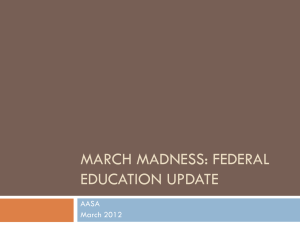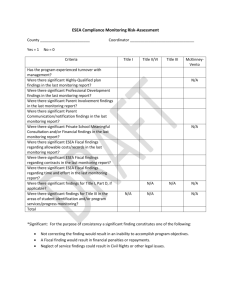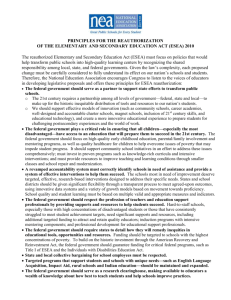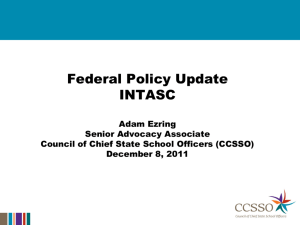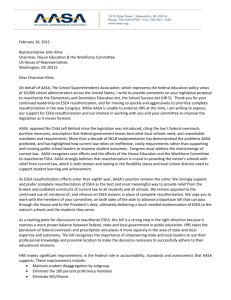Federal Education Update
advertisement
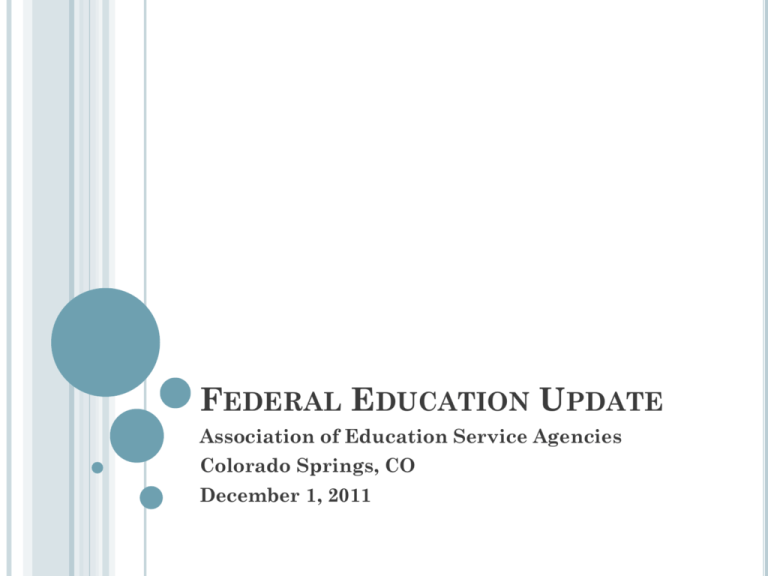
FEDERAL EDUCATION UPDATE Association of Education Service Agencies Colorado Springs, CO December 1, 2011 OVERVIEW ESEA Reauthorization Waivers Title I Formula Fairness Appropriations FY12 Super Committee/Deficit Commission IDEA Full Funding Ed Tech Child Nutrition Rural Education Other Topics Advocacy Resources CLIMATES Funding Political Partisan. Middle ground moderates are gone. Gearing up to an election year Federal Continued recession at state and local level Cessation of ARRA/EduJobs Actual and anticipated cuts from FY11 and FY12 Anticipated cuts from Debt Ceiling Commission/Sequestration Gridlock between House and Senate State State legislatures were heavily impacted by last year’s elections Strong push on education issues with grassroots implications ESEA REAUTHORIZATION Areas of Agreement Measuring Growth Disaggregation Annual summative assessment New higher standards New better assessments SES & Choice, less prescriptive Area of Debate Accountability framework - AYP or growth Assessments – Quality/Type Teacher evaluation – test weight/multiple measures/performance levels Flexibility/transferabilit y – how much/where Charter schools – rules same or different Comparability – the sleeper issue!! ESEA REAUTHORIZATION: HOUSE H.R. 1891 "Setting New Priorities in Education Spending Act" Full Committee Wednesday, May 25, 2011 Ordered favorably reported, as amended, to the House by a vote of 23-16 H.R. 2218, "Empowering Parents through Quality Charter Schools Act" Full Committee Wednesday, June 22, 2011 Ordered favorably reported, as amended, to the House by a vote of 34-5. Voted out of full House 9/13 HR 2445 “State and Local Funding Flexibility Act” Wednesday July 14, 2011 Ordered favorable reported, as amended, to the House by a vote of 23-17 ESEA REAUTHORIZATION: SENATE Marathon Mark Up in late October Bipartisan bill passed out of committee, 16-7 12 Ds and 4 Rs 144 filed amendments 24 adopted 10 rejected The balance were either withdrawn, not offered, ignored, and/or will be offered on the floor ESEA REAUTHORIZATION: SENATE Improvements Eliminates impossible goal of 100% Eliminates AYP and AMOs Eliminates 2 percent testing cap Changes testing requirement for ELL from one year to two years Permits shifting to measure growth while retaining status testing Permit multiple measures Includes computer adaptive assessment Shifts control of accountability to the states Requires adoption of more accurate assessments ESEA REAUTHORIZATION: SENATE Accountability Changes Requires continuous improvement towards C/CR Maintains disaggregation Ranks schools, focus on bottom 5% Achievement Gaps and Persistently Low Achieving Achievement based on test scores, graduation rates, state summative test scores, and % on track for C/CR. Turn Around Models Transformation, Strategic Staffing, Turnaround, Whole School Reform, Restart, Closure, State Flexibility and Rural Waiver ESEA REAUTHORIZATION: SENATE Points of Concern Comparability Changes Reliance on One-Time testing Treatment of Foster Kids Codification of RttT and i3 ESEA: REGULATORY RELIEF • • Flexibility being offered in 11 specific areas States have to adopt all three policy priorities: Higher standards – Differentiated accountability system – Teacher/principal evaluation system based on growth – • • NCLB Waiver Watch: www.cep-dc.org AASA position: we agree with the areas in which flexibility is being provided but are opposed to the conditional nature of the process. ESEA: REGULATORY RELIEF Conditional, quid-pro-quo deal, with states having to adopt specific policy priorities I exchange for relief To date, 39 states have expressed interest in the waivers 11 states submitted applications in the first round: Colorado, Florida, Georgia, Indiana, Kentucky, Massachusetts, Minnesota, New Jersey, New Mexico, Oklahoma and Tennessee Next Deadline for Applying: Mid-February TITLE I FORMULA FAIRNESS www.formulafairness.com Led by Rural School and Community Trust Current statute uses two weighting brackets to determine an LEA’s Title I allocation Unintended consequence is that some larger, less-poor schools can end up receiving more Title I dollars perchild than smaller, poorer districts TITLE I FORMULA FAIRNESS All Children are Equal (ACE) Act (HR 2485) provides legislative fix Turns down the volume on number weighting to ensure that Title I dollars are distributed to concentrations of poverty 11 original co-sponsors: Representatives Glenn Thompson (R-PA), Ruben Hinojosa (D – TX), G.K. Butterfield (D-NC), Louise Slaughter (D-NY), Dan Boren (D-OK), Mike Ross (D-AR), Tom Petri (R-WI), Lou Barletta (R-PA), Mike Kelly (R-PA), Todd Platts (R-PA), and Richard Hanna (R-NY). Also joined by Reps. Roby (R-AL), Hartzler (R-MO), and Crawford (R-AR) Urge your representative to sign on! FY12 APPROPRIATIONS House: Education down over all, huge increases for Title I and IDEA, cuts for many other ed programs Senate: overall increase for education, lack funding increases for Title I and IDEA Current Dear Colleague in the House; Sign on by Friday! FY12: Started October 1, without a budget First CR thru 11/18; Current CR thru 12/16 Differing House and Senate Edu Numbers Role of final approps bills vs. CR vs. megabus FY12 APPROPRIATIONS First CR Included $329 m in cuts to education programs Title I: $163 million IDEA part B: $129 million Title II: $25 million Perkins: $12 million Reach out to your Senator and Representative to urge them to reinstate the funds. FY12 APPROPRIATIONS Joint Deficit Commission Super Committee Roster: Senate: Murray (WA), Baucus (MT), Kerry (MA), Kyl (AZ), Portman (OH), and Toomey (PA) House: Hensarling (TX), Becerra (CA), Camp (MI), Clyburn (SC), Upton (MI), and VanHollen (MD) Has to identify $1.5 trillion in cuts over the next 10 years Failed to announce plan by Thanksgiving and take vote by Christmas Includes required vote on Balanced Budget Amendment House failed to pass BBA FY12 APPROPRIATIONS Potential Cuts in the Deficit Debacle Sequestration triggered 1/1/12 Cuts go in to effect 1/1/13 CBO estimates sequestration will be a 7.8% acrossthe-board cut Estimated Education Impact: Title I: $1.1 billion IDEA: 978 million Perkins: $136 million Head Start: $590 million IDEA FULL FUNDING AASA’s #1 legislative priority Senator Harkin has introduced the IDEA Full Funding Act (S 1403). We are waiting for the House partner bill. Rep. Polis has a IDEA funding bill, but our focus is on the Harkin version Urge your Senator to sign on the S 1403, and talk with your entire Congressional delegation about the funding pressures of IDEA and the importance of protecting and increasing IDEA funding in FY12 and debt ceiling conversations. EDUCATION TECHNOLOGY: E-RATE FCC program that provides discounts to help schools and libraries afford telecommunications services Anti-Deficiency Act (S 297) Raise the spending cap Waiting for final action by the FCC on a host of rules/notices: Gift rule CIPA Roll-over funds EDUCATION TECHNOLOGY: ED TECH Title II Part D, Enhancing Education Through Technology, E2T2 Zero-funded by the administration, eliminated by the House in its ESEA eliminations bill Not included in Senate Base Bill Sen. Bingaman introduced the ATTAIN Act (S 1178), which allows for EETT-type program ($300 m trigger); Offered as amendment in Senate ESEA mark up CHILD NUTRITION NSLP/SBP reauthorized last December AASA, NSBA and Council opposed unfunded mandates within the law Increased reimbursement, higher nutrition standards Set paid lunch price Set training and certification requirements Review indirect cost process Continue to work on the regulations, which affirm our suspicions Hullabaloo in the FY12 agriculture appropriations bill related to language that limits the use of FY12 funds for implementing new language AMENDMENTS TO REAP Changes to REAP in Senate version of ESEA Transition to new locale codes (move from 7/8 to 33, 41, 42, 43) Allow districts to choose between RLIS and SRSA funding If appropriation for REAP is increased, base grant moves from 20 to 25, max grant goes from 60 to 80 Changes not made to Senate Version of ESEA Transition to FRLP as poverty measure from 20% census data OFFICE OF RURAL EDUCATION POLICY ACT Bill introduced in May; Goal: Adding it to ESEA Would establish an Office inside the Dept of Ed headed by a Director who would Advise the Secretary on the needs of rural schools and ensure that all regulations issued by the Department of Education explicitly consideration the impact that the regulations will have on rural schools and communities maintain a clearinghouse on best practices and research for rural schools, produce an annual report to Congress, coordinate efforts throughout federal agencies related to rural schools OTHER ISSUES Federal Mandates RttT, I3, SIG Foster Care Bullying Common Core/Testing Consortia America’s Jobs Act GET—AND STAY—INVOLVED! • • • • • Weigh in early, weigh in often These decisions are made whether or not you weigh in. 15 minutes per month is all it takes. Get to know your Senator/Representative, and perhaps more importantly, their education staffer. Invite the Representative/Senator and staffer to your ESA. Anecdotes and stories have a lot of sticking power with this Congress. Let the face of your ESA be the one that sticks in their mind! AASA/AESA ADVOCACY RESOURCES AASA Website: www.aasa.org AASA Blog: www.aasa.org/aasablog.aspx AASA Twitter: @Noellerson AASA Legislative Corps: Weekly Newsletter Advocacy Network: Monthly Update QUESTIONS? Noelle Ellerson Assistant Director, Policy Analysis & Advocacy nellerson@aasa.org
